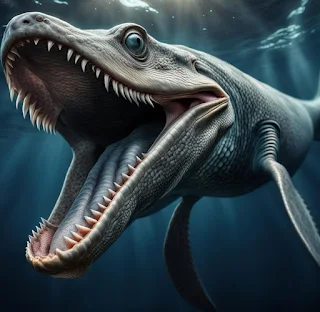Jurassic Ocean Predators
During the Jurassic period, the region around Africa was surrounded by monster marine predators.
From approximately 201 to 145 million years ago, the Jurassic period was a pivotal age in Earth's history marked by the dominance of supercontinents and supermarine predators.
The western coast of present-day Africa, a crucial part of Gondwana's ancient supercontinent, held a unique place in this prehistoric web of apex marine predators.
The influence of the Tethys Sea and the presence of remarkable marine reptiles like ichthyosaurs, plesiosaurs, and pliosaurs were apex predators; they played key roles in regulating prey populations and shaping the evolutionary paths of other marine life.
Supercontinent of Gondwana, Sea Monsters and the Ancient Tethys Sea.
During the Jurassic period, Gondwana, a vast supercontinent, included the landmasses that would later become South America, Africa, Antarctica, Australia, the Indian subcontinent, and the Arabian Peninsula.
The western coast of present-day Africa formed a significant part of Gondwana's southern region. This region's geological dynamics were partly shaped by the presence of the Tethys Sea, an expansive ocean that separated Gondwana from the northern landmasses of Laurasia.
The Tethys Sea, an epicontinental sea that existed particularly in the Mesozoic era, played a critical role in shaping the climate, geography, and biodiversity along the western coast of Gondwana. Its vast expanse and unique conditions created a perfect environment for developing apex marine predators that thrived in these ancient waters.
The size of the Tethys Sea changed as tectonic forces led to the opening and closing of ocean basins and the shifting of continents. The Tethys Sea was reduced and divided into smaller sub-basins during the tectonic plate convergence.
The Tethys Sea was home to an array of marine life, including ammonites, bivalves, cephalopods, and planktonic organisms, along with apex predators: the Ichthyosaurs, Plesiosaurs, and Pliosaurs, which ultimately left their mark on the geological record, and contributed to the development of life on Earth.
Three Epic Fearsome Marine Predators are Ichthyosaurs, Plesiosaurs, and Pliosaurs.
Modern apex predators such as great white sharks, killer whales, and large predatory fish are found off the west coast of Africa.
Millions of years ago Jurassic seas along the western coast of Gondwana swam extraordinary marine reptiles. Ichthyosaurs, plesiosaurs, and pliosaurs.
They were among the rulers of the underwater realm, each adapted to its unique niche in the marine ecosystem. Great white sharks, killer whales, and large predatory fish had no chance of survival amongst these monsters of the sea.
Ichthyosaurs
Ichthyosaurs were sleek, dolphin-like reptiles that ruled the open seas. Their streamlined bodies, fins, and sharp teeth equipped them for a life of swift pursuit and efficient hunting. Fossil evidence suggests that ichthyosaurs were well-represented along the western coast of Gondwana, indicating the region's significance as a prime habitat for these marine predators.
Shonisaurus sikanniensis is considered one of the largest ichthyosaurs, with estimates suggesting lengths of up to 21 meters or 69 feet. This is significantly larger than common marine life. For perspective, the average length of a killer whale, orca, a large contemporary marine mammal, is around 7 to 8 meters or 23 to 26 feet.
Plesiosaurs
Plesiosaurs were another group of marine reptiles that inhabited the Jurassic seas. Unlike ichthyosaurs, plesiosaurs had distinct long necks and paddle-like limbs. Their presence in the waters off the western coast of Gondwana added a layer of complexity to the marine ecosystem, showcasing the diversity of life during this period.
Elasmosaurus platyurus is among the largest plesiosaurs, with an estimated length of about 14 meters or 46 feet. Compared to everyday marine life, this plesiosaur would be longer than the average adult male great white shark, typically reaching around 4 to 6 meters or 13 to 20 feet.
Pliosaurs
Pliosaurs, characterized by their large heads and short necks, were apex predators in the Jurassic seas. These formidable reptiles patrolled the coastal waters, preying on fish and other marine creatures. The fossil record indicates that pliosaurs left an indelible mark on the western coast of Gondwana, contributing to the intricate web of life in the ancient ocean.
Pliosaurus funkei is one of the largest pliosaurs, estimated to be around 12 meters or 39 feet. In contrast to ordinary USA marine life, this pliosaur would be longer than most adult male sea lions, which generally reach 2 to 2.5 meters or 6.5 to 8.2 feet.
During the Jurassic period, the western coast of present-day Africa was a part of the Gondwanan landscape and witnessed a rich geological and biological phenomenon. The impact of the Tethys Sea and the presence of iconic marine reptiles such as ichthyosaurs, plesiosaurs, and pliosaurs created a diverse and dynamic marine ecosystem.
These geological and paleontological wonders, including the apex predators mentioned earlier, played crucial roles in regulating prey populations and shaping the evolutionary paths of other marine organisms around present-day Africa during the Jurassic period.




